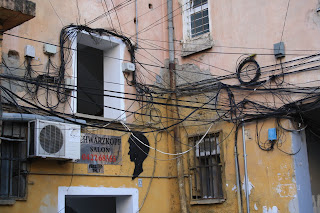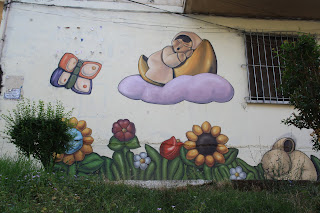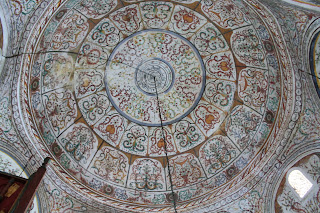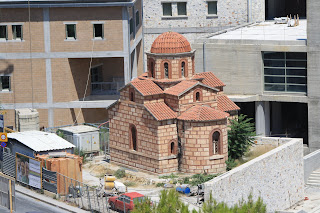Yesterday, July 16, Sylvia and I left the house early and wondered around some (mostly) back streets in Tirana. For those of you familiar with the city, we walked from Selite, where our house is, down Myslim Shyri, some streets parallel to Myslim Shyri, to the old section of town, i.e., the Et'hem Bey mosque, Tabake bridge. Then to Stephens Center, through the market, east toward the Red School, then toward the Ring Road by the train station, and back down Zogu I to the Taiwan Center and a cold beer -- or two cold beers.
This is behind Myslim Shyri, some of the wiring nests one sees everywhere. Very little electrical here -- this is mostly telephone and cable. The bigger cables are electric.

Building across the street from Tori Drin, clock tower in the back. I don't know what this building was built for. I've always thought it looked like a depo of some sort.
 The old house (1827 I think) next to Tori Drin.
The old house (1827 I think) next to Tori Drin.

 The old house (1827 I think) next to Tori Drin.
The old house (1827 I think) next to Tori Drin.
Castle wall. It's called a castle, but "palace" or "city mansion" might be more appropriate. The old Roman wall, which is the one two or stree courses high, was discovered during the construction of the new pedestrian walkway, and the walkway was redesigned to accomodate it.


Old government building across the street from Parliament. The monument to those who died under communism is at the bottom right.


Ura e tabakeve, or tanner's bridge. This used to cross the Lana River in the 18th century. The river was rerouted as the city grew.


The new pedestrian path, which runs from the bridge to the Boulevard.


The new pedestrian path, which runs from the bridge to the Boulevard.
The results of a momentary display of irrational exuberance.
This building has been under construction since we've been in Tirana. Is it smaller at the bottom than the top? Apparently reasonable minds can differ.


Tobacco, pure and unadulterated, with bags of filters and rolling papers, ready for purchase by the health-conscious consumer.


Rr. Qemal Stafa, east toward the Red School. This is the bicycle/motorcycle part of the street, one shop after the other. Other sections of the street have old collectibles (including two $1 silver certificates), furniture, and all sorts of other stuff.


Old villa.
Catholic church, in use but not quite finished. At least the bell tower is not totally clad with the fascia stone.




Another design. In many old neighborhoods the one and two storey old house complexes are surrounded by high-rises.

 Restaurant and fish house on the fourth floor.
Restaurant and fish house on the fourth floor.


 Restaurant and fish house on the fourth floor.
Restaurant and fish house on the fourth floor.
Villa Goldi, now a restaurant and hotel. If I remember correctly it was built in 1927. Not sure what it was built for originally.


They stuccoed and painted (institutional green) the front part and show no signs of stuccoing the rear portion.


Untitled I
A little neighborhood store with snack food and sundry items. Not sure what this little girl's role is -- call her mom when someone comes, I guess.


This gentleman was painting the addition to his apartment. He has a first floor apartment in an old, typical 5-floor communist-ear apartment building. It is about 150 feet from the Ring Road. He said he was a painter, an artist.
By the train station. In the running for the ugliest building in Tirana.
On Zogu I, the Ministry of Justice Building in the foreground. ALso in the running for the ugliest award.


In the running for the prettiest, the Et'hem Bey Mosque. Painting on the cupola, the balcony, and the main floor.














































